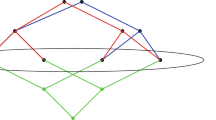Abstract
We study fault-tolerant spanners in doubling metrics. A subgraph H for a metric space X is called a k-vertex-fault-tolerant t-spanner ((k,t)-VFTS or simply k-VFTS), if for any subset S⊆X with |S|≤k, it holds that d H∖S (x,y)≤t⋅d(x,y), for any pair of x,y∈X∖S.
For any doubling metric, we give a basic construction of k-VFTS with stretch arbitrarily close to 1 that has optimal O(kn) edges. In addition, we also consider bounded hop-diameter, which is studied in the context of fault-tolerance for the first time even for Euclidean spanners. We provide a construction of k-VFTS with bounded hop-diameter: for m≥2n, we can reduce the hop-diameter of the above k-VFTS to O(α(m,n)) by adding O(km) edges, where α is a functional inverse of the Ackermann’s function.
Finally, we construct a fault-tolerant single-sink spanner with bounded maximum degree, and use it to reduce the maximum degree of our basic k-VFTS. As a result, we get a k-VFTS with O(k 2 n) edges and maximum degree O(k 2).

Similar content being viewed by others
References
Arya, S., Das, G., Mount, D.M., Salowe, J.S., Smid, M.H.M.: Euclidean spanners: short, thin, and lanky. In: STOC, pp. 489–498 (1995)
Callahan, P.B., Kosaraju, S.R.: Faster algorithms for some geometric graph problems in higher dimensions. In: SODA, pp. 291–300 (1993)
Chan, T.-H.H., Gupta, A.: Small hop-diameter sparse spanners for doubling metrics. Discrete Comput. Geom. 41(1), 28–44 (2009)
Chan, T.-H.H., Gupta, A., Maggs, B.M., Zhou, S.: On hierarchical routing in doubling metrics. In: SODA, pp. 762–771 (2005)
Chan, T.-H.H., Li, M., Ning, L.: Incubators vs zombies: fault-tolerant, short, thin and lanky spanners for doubling metrics (2012). arXiv:1207.0892 [cs.Os]
Chazelle, B.: Computing on a free tree via complexity-preserving mappings. Algorithmica 2, 337–361 (1987)
Chechik, S., Langberg, M., Peleg, D., Roditty, L.: Fault-tolerant spanners for general graphs. In: STOC, pp. 435–444 (2009)
Czumaj, A., Zhao, H.: Fault-tolerant geometric spanners. Discrete Comput. Geom. 32(2), 207–230 (2004)
Das, G., Narasimhan, G.: A fast algorithm for constructing sparse Euclidean spanners. In: Symposium on Computational Geometry, pp. 132–139 (1994)
Dinitz, M., Krauthgamer, R.: Fault-tolerant spanners: better and simpler. In: PODC, pp. 169–178 (2011)
Dinitz, Y., Elkin, M., Solomon, S.: Shallow-low-light trees, and tight lower bounds for Euclidean spanners. In: FOCS, pp. 519–528 (2008)
Elkin, M., Solomon, S.: Narrow-shallow-low-light trees with and without steiner points. SIAM J. Discrete Math. 25(1), 181–210 (2011)
Elkin, M., Solomon, S.: Optimal Euclidean spanners: really short, thin and lanky. In: STOC (2013, to appear)
Gao, J., Guibas, L.J., Nguyen, A.: Deformable spanners and applications. In: SoCG, pp. 190–199 (2004)
Gottlieb, L.-A., Roditty, L.: An optimal dynamic spanner for doubling metric spaces. In: ESA, pp. 478–489 (2008)
Gupta, A., Krauthgamer, R., Lee, J.R.: Bounded geometries, fractals, and low-distortion embeddings. In: FOCS, pp. 534–543 (2003)
Har-Peled, S., Mendel, M.: Fast construction of nets in low dimensional metrics, and their applications. In: Symposium on Computational Geometry, pp. 150–158 (2005)
Levcopoulos, C., Narasimhan, G., Smid, M.H.M.: Efficient algorithms for constructing fault-tolerant geometric spanners. In: STOC, pp. 186–195 (1998)
Lukovszki, T.: New results of fault tolerant geometric spanners. In: WADS, pp. 193–204 (1999)
Narasimhan, G., Smid, M.H.M.: Geometric Spanner Networks. Cambridge University Press, Cambridge (2007)
Solomon, S.: Fault-tolerant spanners for doubling metrics: better and simpler (2012). arXiv:1207.7040 [cs.Os]
Solomon, S., Elkin, M.: Balancing degree, diameter and weight in Euclidean spanners. In: ESA (1), pp. 48–59 (2010)
Tarjan, R.E.: Efficiency of a good but not linear set union algorithm. J. ACM 22(2), 215–225 (1975)
Author information
Authors and Affiliations
Corresponding author
Rights and permissions
About this article
Cite this article
Chan, TH.H., Li, M. & Ning, L. Sparse Fault-Tolerant Spanners for Doubling Metrics with Bounded Hop-Diameter or Degree. Algorithmica 71, 53–65 (2015). https://doi.org/10.1007/s00453-013-9779-y
Received:
Accepted:
Published:
Issue Date:
DOI: https://doi.org/10.1007/s00453-013-9779-y




